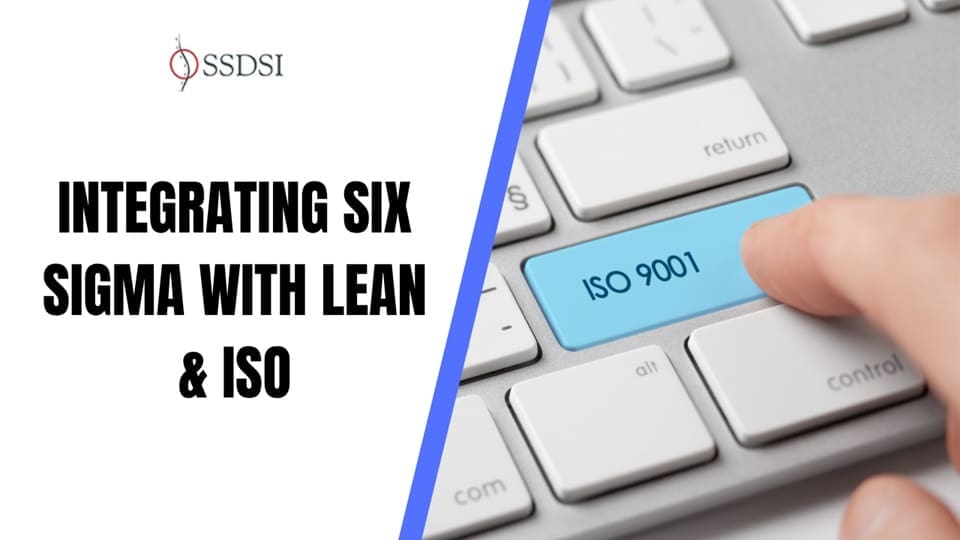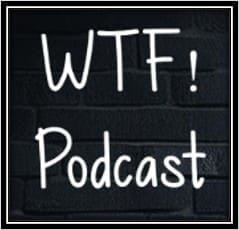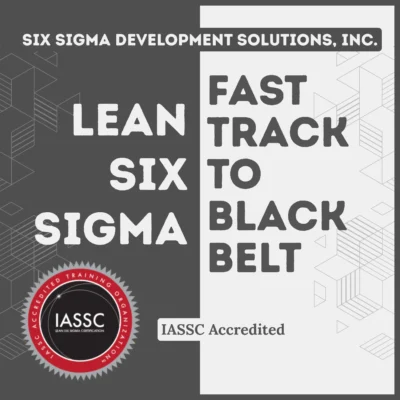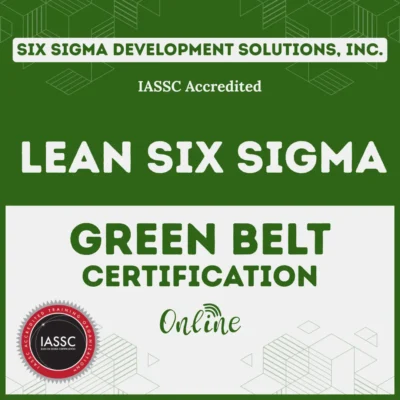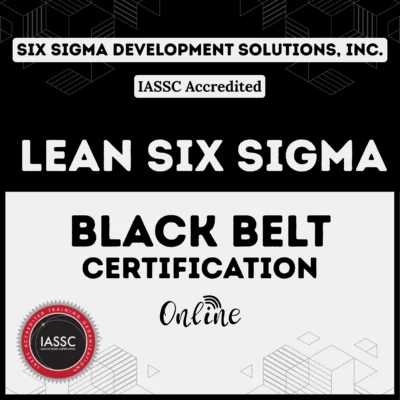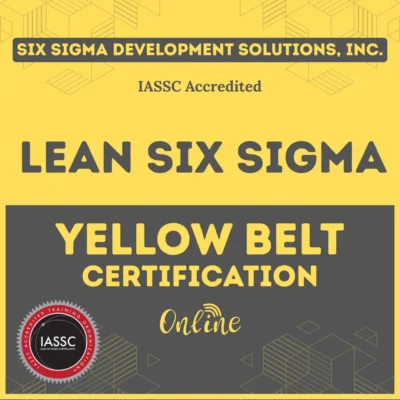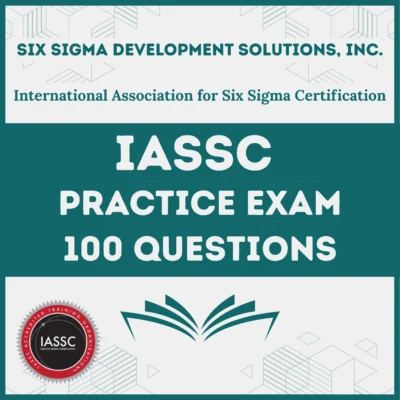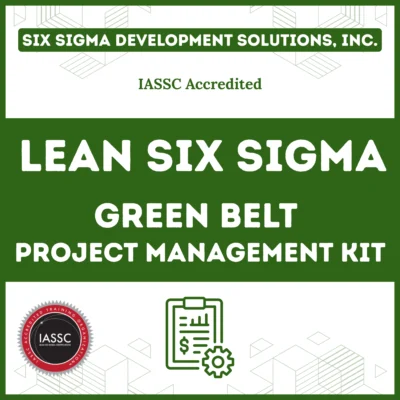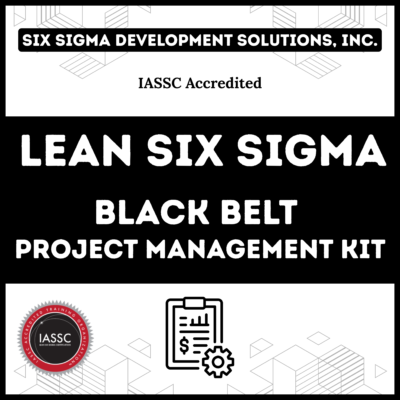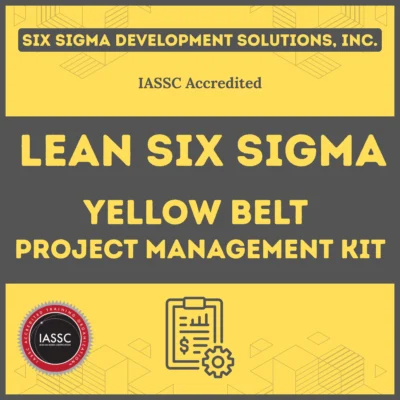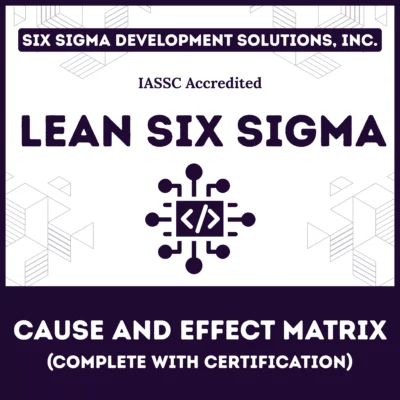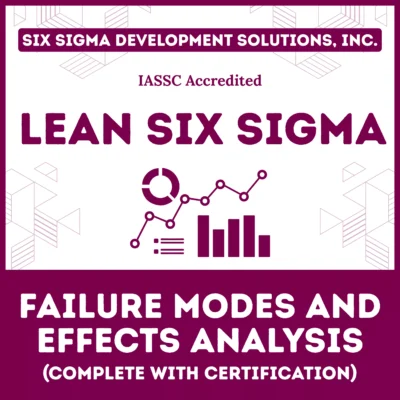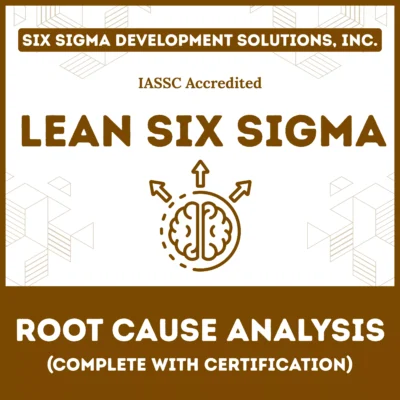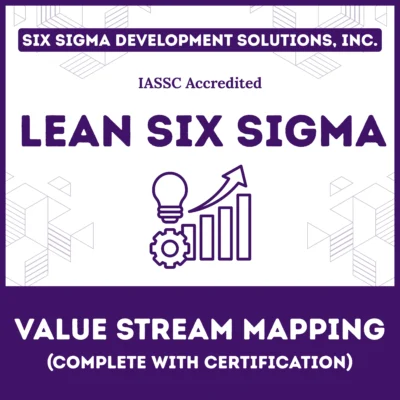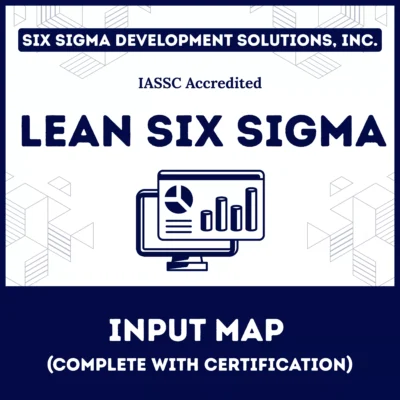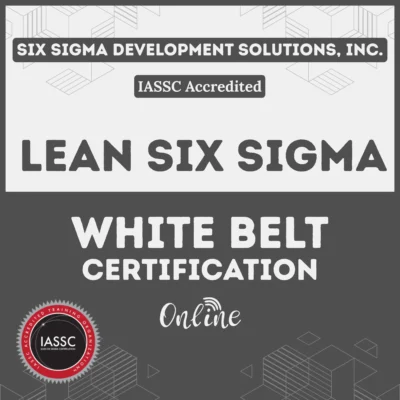Quality excellence doesn’t happen by accident. Organizations worldwide constantly search for methodologies that deliver consistent improvements, reduce waste, and enhance customer satisfaction. While Six Sigma stands as a powerful quality management approach on its own, its true potential emerges when integrated with complementary frameworks like Lean and ISO standards.
The question many business leaders ask isn’t whether to adopt quality frameworks, but rather how to combine them effectively. This comprehensive guide explores practical strategies for integrating Six Sigma with other quality methodologies, revealing how organizations can create synergistic systems that drive exceptional results.
Table of contents
What is Six Sigma, and Why Integrate It?
Six Sigma is a data-driven methodology that aims to eliminate defects and improve processes by focusing on statistical analysis and problem-solving. Rooted in the DMAIC framework (Define, Measure, Analyze, Improve, Control), it’s a disciplined approach to achieving near-perfect quality—targeting a maximum of 3.4 defects per million opportunities.
However, Six Sigma doesn’t operate in a vacuum. Businesses often use other frameworks like Lean, which focuses on eliminating waste, or ISO standards, which emphasize consistent quality management. Integrating these methodologies creates a holistic system that addresses multiple facets of operational excellence.
By combining Six Sigma’s precision with Lean’s efficiency and ISO’s standardization, organizations can streamline processes, reduce costs, and enhance customer satisfaction.
Why Integration Matters?
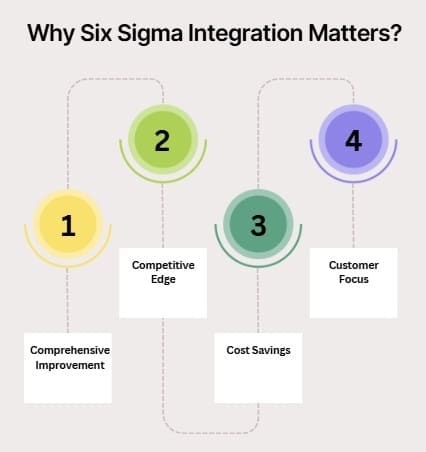
- Comprehensive Improvement: Six Sigma tackles defects, Lean eliminates waste, and ISO ensures consistency, covering all bases for quality management.
- Competitive Edge: Integrated frameworks help businesses stay agile and responsive in dynamic markets.
- Cost Savings: Combining methodologies reduces redundancies and optimizes resources.
- Customer Focus: A unified approach enhances product quality, meeting customer expectations consistently.
Public, Onsite, Virtual, and Online Six Sigma Certification Training!
- We are accredited by the IASSC.
- Live Public Training at 52 Sites.
- Live Virtual Training.
- Onsite Training (at your organization).
- Interactive Online (self-paced) training,
Understanding Lean and ISO
Before diving into integration strategies, let’s clarify what Lean and ISO bring to the table.
Lean: The Art of Efficiency
Lean, born from Toyota’s production system, focuses on creating value for customers by eliminating waste—think excess inventory, overproduction, or unnecessary steps in a process. Lean’s core principles include:
- Value Stream Mapping: Identifying and optimizing every step in a process.
- Continuous Flow: Ensuring smooth, uninterrupted workflows.
- Kaizen: Promoting continuous, incremental improvements.
Lean’s strength lies in its simplicity and speed, making it a natural partner for Six Sigma’s analytical rigor.
ISO Standards: The Blueprint for Consistency
ISO standards, particularly ISO 9001, provide a framework for quality management systems (QMS). They emphasize standardized processes, documentation, and customer satisfaction. Key elements include:
- Process Standardization: Ensuring consistent operations across the organization.
- Risk Management: Identifying and mitigating risks to quality.
- Continuous Improvement: Aligning with Plan-Do-Check-Act (PDCA) cycles.
ISO’s structured approach complements Six Sigma’s data-driven problem-solving and Lean’s waste reduction, creating a powerful trio.
Also See: Lean Six Sigma Training Madison Wisconsin
Strategies for Integrating Six Sigma with Lean and ISO
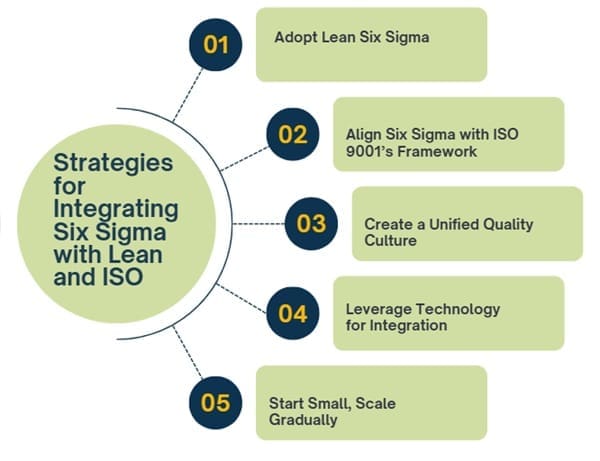
Integrating Six Sigma with Lean and ISO requires a strategic approach that aligns their strengths while addressing potential challenges. Here’s how to do it effectively.
1. Adopt Lean Six Sigma
Lean Six Sigma combines the best of both worlds—Six Sigma’s defect reduction and Lean’s waste elimination. This hybrid methodology streamlines processes while ensuring high quality. Here’s how to implement it:
- Map the Process: Use Lean’s Value Stream Mapping to identify waste and bottlenecks, then apply Six Sigma’s DMAIC to analyze and improve specific issues.
- Focus on Customer Value: Define value from the customer’s perspective (Lean) and use Six Sigma’s metrics to ensure quality meets those expectations.
- Train Teams: Invest in Lean Six Sigma training (Green Belt, Black Belt) to equip employees with tools like statistical process control and kaizen events.
Example: A manufacturing firm might use Lean to reduce excess inventory, then apply Six Sigma to analyze defect rates in production, achieving both efficiency and quality.
2. Align Six Sigma with ISO 9001’s Framework
ISO 9001’s PDCA cycle dovetails seamlessly with Six Sigma’s DMAIC. Here’s how to align them:
- Define and Document: Use ISO’s documentation requirements to define processes in the DMAIC “Define” phase, ensuring clarity and consistency.
- Measure and Monitor: Leverage ISO’s emphasis on metrics to support Six Sigma’s data collection and analysis.
- Improve and Control: Combine ISO’s continuous improvement focus with Six Sigma’s control phase to sustain gains.
Example: A healthcare provider might use ISO 9001 to standardize patient care processes, then apply Six Sigma to reduce errors in medication administration, ensuring compliance and quality.
3. Create a Unified Quality Culture
Integration isn’t just about tools—it’s about people. Build a culture that embraces all three frameworks:
- Leadership Commitment: Ensure top management supports the integration, aligning goals across Six Sigma, Lean, and ISO initiatives.
- Cross-Functional Teams: Form teams with expertise in all three methodologies to foster collaboration and knowledge sharing.
- Communication: Clearly communicate the benefits of integration to employees, emphasizing how it drives efficiency, quality, and customer satisfaction.
4. Leverage Technology for Integration
Modern technology, like data analytics platforms and process automation tools, can bridge the gap between Six Sigma, Lean, and ISO. For instance:
- Data Analytics: Use software like Minitab or Tableau to support Six Sigma’s statistical analysis and Lean’s process mapping.
- QMS Software: Tools like Qualio or MasterControl align with ISO 9001’s documentation needs while supporting Six Sigma’s data-driven approach.
- Automation: Implement robotic process automation (RPA) to eliminate repetitive tasks (Lean) and ensure consistent quality (ISO).
5. Start Small, Scale Gradually
Integration can be overwhelming, so begin with pilot projects:
- Select a Process: Choose a single process, like order fulfillment, to test the integration of Six Sigma, Lean, and ISO.
- Measure Success: Track key performance indicators (KPIs) like defect rates, cycle time, and customer satisfaction.
- Scale Up: Once successful, expand the approach to other areas of the organization.
Benefits of Integrating Six Sigma with Lean and ISO
When executed well, this integration delivers transformative results:
- Enhanced Efficiency: Lean eliminates waste, while Six Sigma optimizes processes, reducing costs and cycle times.
- Improved Quality: Six Sigma’s defect reduction and ISO’s standardization ensure consistent, high-quality outputs.
- Regulatory Compliance: ISO alignment helps meet industry standards, reducing compliance risks.
- Customer Satisfaction: A focus on value (Lean), quality (Six Sigma), and consistency (ISO) delights customers.
- Employee Engagement: A unified approach empowers employees to contribute to continuous improvement.
Overcoming Common Integration Challenges
Even well-planned integration efforts encounter obstacles. Recognizing common challenges helps you prepare effective responses.
Managing Resistance to Change
One of the most common challenges in implementing Lean Six Sigma is resistance to change from employees accustomed to existing processes. People naturally resist disruption to familiar routines, especially when they perceive quality initiatives as additional work rather than helpful tools.
Address resistance by:
- Communicating benefits clearly and repeatedly
- Involving employees in identifying problems and solutions
- Providing comprehensive training before expecting adoption
- Starting with willing volunteers who can become advocates
- Demonstrating quick wins that prove value
Balancing Competing Priorities
Organizations often struggle with competing quality initiatives. Should you focus on Lean waste reduction or Six Sigma defect elimination? Does ISO compliance take precedence over improvement projects?
Resolve conflicts by:
- Establishing clear governance structures that prioritize work
- Recognizing that frameworks complement rather than compete
- Aligning quality goals with strategic business objectives
- Allocating dedicated resources to quality initiatives
- Creating integrated project selection criteria
Maintaining Momentum Through Leadership Changes
Quality transformations span years, but leaders often move to new roles more frequently. Maintaining momentum through leadership transitions requires:
- Documenting your integration approach and rationale
- Embedding quality practices in organizational culture
- Demonstrating tangible business results regularly
- Building broad support across leadership teams
- Celebrating progress milestones publicly
Avoiding Over-Complexity
The desire to implement everything simultaneously creates confusion and dilutes focus. Technical barriers emerge when teams lack statistical knowledge or improvement experience, which organizations overcome by providing just-in-time training focused on immediate project needs.
Keep integration manageable by:
- Introducing tools progressively as teams need them
- Focusing on practical application over theoretical perfection
- Simplifying approaches for less complex problems
- Building capability gradually through project work
- Resisting the temptation to adopt every available tool
Creating Your Integration Action Plan
Ready to begin integrating quality frameworks in your organization? Follow this practical action plan to start your journey.
Immediate Actions (This Month)
- Assess your current state by reviewing existing quality practices and identifying gaps
- Form a steering committee with cross-functional leaders committed to quality
- Identify a pilot area where integration can demonstrate clear value
- Secure executive sponsorship by presenting the business case for integration
Short-Term Actions (Next 3-6 Months)
- Develop detailed implementation plans specifying timelines, resources, and responsibilities
- Train core teams in Lean, Six Sigma, and ISO fundamentals
- Launch pilot projects applying integrated approaches
- Establish metrics for tracking progress and demonstrating value
- Communicate regularly about goals, progress, and early wins
Long-Term Actions (6-24 Months)
- Expand successful practices to additional departments and processes
- Refine your approach based on lessons learned from early projects
- Build internal capability by training more practitioners
- Integrate quality into management systems so it becomes how you naturally work
- Celebrate achievements while maintaining focus on continuous improvement
Also Read: Compliance and Risk Management
Examples of Successful Integration
Case Study 1: General Electric (GE)
GE famously pioneered Six Sigma in the 1990s, later integrating it with Lean to streamline manufacturing. By aligning Lean Six Sigma with ISO 9001, GE reduced production defects by 70% and saved billions in costs, proving the power of integration.
Case Study 2: Toyota
Toyota, the birthplace of Lean, adopted Six Sigma principles to enhance quality control. By aligning with ISO standards, Toyota maintained global consistency, ensuring its reputation for reliability and efficiency.
Strategic Approaches to Framework Integration
Here are proven strategies that organizations use to create integrated quality systems.
Start with ISO as Your Foundation
ISO standards provide an excellent starting point for integration because they establish the documented processes and management systems that support other methodologies. Begin by:
- Implementing ISO 9001 requirements to create your quality management system structure
- Documenting core processes that will later become targets for improvement
- Establishing measurement systems that feed data to Six Sigma projects
- Creating a culture of accountability through regular audits and reviews
Layer Lean for Operational Excellence
After establishing your ISO framework, introduce Lean principles to optimize workflow and eliminate waste. This sequence works effectively because:
- ISO documentation reveals process steps that Lean can streamline
- Standard operating procedures make it easier to identify non-value-added activities
- The management review process provides a forum for discussing Lean initiatives
Apply Six Sigma to Critical Quality Issues
While Lean emphasizes routine management, process standardization, and the study of times and movements to eliminate waste, Six Sigma focuses on finding root causes for problems. This makes Six Sigma ideal for addressing persistent quality issues that resist simpler solutions.
Deploy Six Sigma projects when you encounter:
- High defect rates despite Lean improvements
- Customer complaints about quality variation
- Complex problems requiring statistical analysis
- Processes where small improvements yield significant financial returns
Create the Lean Six Sigma Hybrid
Many organizations find that combining Lean and Six Sigma into a single “Lean Six Sigma” methodology delivers superior results. During the 2000s, Lean Six Sigma forked from Six Sigma and became its own unique process, incorporating ideas from lean manufacturing.
FAQs on Integrating Six Sigma with Lean & ISO
What is the difference between Six Sigma, Lean, and ISO?
Six Sigma focuses on reducing defects through data-driven methods, Lean eliminates waste to improve efficiency, and ISO (like ISO 9001) standardizes processes for consistent quality.
Can Lean and Six Sigma be used together?
Yes! Lean Six Sigma combines Lean’s waste reduction with Six Sigma’s defect elimination, creating a powerful approach to process improvement.
How does ISO 9001 complement Six Sigma?
ISO 9001’s PDCA cycle aligns with Six Sigma’s DMAIC, providing a framework for documentation, standardization, and continuous improvement.
What are the benefits of integrating these frameworks?
Integration enhances efficiency, improves quality, ensures compliance, boosts customer satisfaction, and fosters a culture of continuous improvement.
How do I start integrating Six Sigma with Lean and ISO?
Begin with a pilot project, train your team in all three methodologies, align goals with customer value, and use technology to streamline processes.
Final Words
Integrating Six Sigma with Lean and ISO is like assembling a dream team for quality management. Each framework brings unique strengths—Six Sigma’s precision, Lean’s efficiency, and ISO’s consistency—creating a synergy that drives operational excellence. By adopting strategies like Lean Six Sigma, aligning with ISO’s framework, and fostering a unified quality culture, businesses can achieve remarkable results.

About Six Sigma Development Solutions, Inc.
Six Sigma Development Solutions, Inc. offers onsite, public, and virtual Lean Six Sigma certification training. We are an Accredited Training Organization by the IASSC (International Association of Six Sigma Certification). We offer Lean Six Sigma Green Belt, Black Belt, and Yellow Belt, as well as LEAN certifications.
Book a Call and Let us know how we can help meet your training needs.

